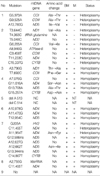1. Naviaux RK. Mitochondrial DNA disorders. Eur J Pediatr. 2000. 159:Suppl 3. S219–S226.

2. Bianchi NO, Bianchi MS, Richard SM. Mitochondrial genome instability in human cancers. Mutat Res. 2001. 488:9–23.

3. Richter C, Park JW, Ames BN. Normal oxidative damage to mitochondrial and nuclear DNA is extensive. Proc Natl Acad Sci USA. 1988. 85:6465–6467.

4. Wallace DC. Mitochondrial diseases in man and mouse. Science. 1999. 283:1482–1488.

5. Chinnery PF, Johnson MA, Wardell TM, Singh-Kler R, Hayes C, Brown DT, Taylor RW, Bindoff LA, Turnbull DM. The epidemiology of pathogenic mitochondrial DNA mutations. Ann Neurol. 2000. 48:188–193.

6. Young NS. Acquired aplastic anemia. JAMA. 1999. 282:271–278.

7. Hatfill SJ, La Cock CJ, Laubscher R, Downing TG, Kirby R. A role for mitochondrial DNA in the pathogenesis of radiation-induced myelodysplasia and secondary leukemia. Leuk Res. 1993. 17:907–913.

8. Rowe TC, Weissig V, Lawrence JW. Mitochondrial DNA metabolism targeting drugs. Adv Drug Deliv Rev. 2001. 49:175–187.

9. Adachi K, Fujiura Y, Mayumi F, Nozuhara A, Sugiu Y, Sakanashi T, Hidaka T, Toshima H. A deletion of mitochondrial DNA in murine doxorubicin-induced cardiotoxicity. Biochem Biophys Res Commun. 1993. 195:945–951.

10. Shin MG, Kajigaya S, Levin BC, Young NS. Mitochondrial DNA mutations in patients with myelodysplastic syndromes. Blood. 2003. 101:3118–3125.

11. Levin BC, Cheng H, Reeder DJ. A human mitochondrial DNA standard reference material for quality control in forensic identification, medical diagnosis, and mutation detection. Genomics. 1999. 55:135–146.

12. Andrews RM, Kubacka I, Chinnery PF, Lightowlers RN, Turnbull DM, Howell N. Reanalysis and revision of the Cambridge reference sequence for human mitochondrial DNA. Nat Genet. 1999. 23:147.

13. Chinnery PF, Turnbull DM. Mitochondrial DNA mutations in the pathogenesis of human disease. Mol Med Today. 2000. 6:425–432.

14. Rotig A, Bourgeron T, Chretien D, Rustin P, Munnich A. Spectrum of mitochondrial DNA rearrangements in the Pearson marrow-pancreas syndrome. Hum Mol Genet. 1995. 4:1327–1330.

15. Gattermann N. From sideroblastic anemia to the role of mitochondrial DNA mutations in myelodysplastic syndromes. Leuk Res. 2000. 24:141–151.

16. Shin MG, Kajigaya S, McCoy JP Jr, Levin BC, Young NS. Marked mitochondrial DNA sequence heterogeneity in single CD34+ cell clones from normal adult bone marrow. Blood. 2004. 103:553–561.

17. Gattermann N. Mitochondrial DNA mutations in the hematopoietic system. Leukemia. 2004. 18:18–22.







 PDF
PDF ePub
ePub Citation
Citation Print
Print




 XML Download
XML Download